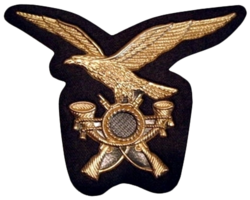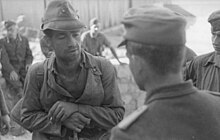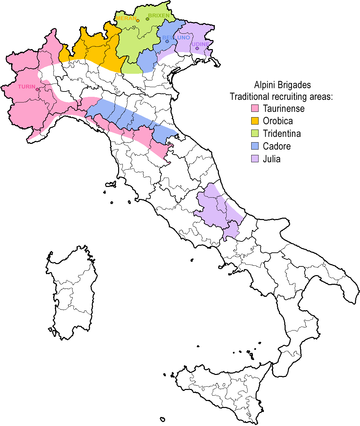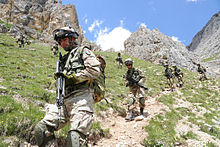Alpini
| Alpini | |
|---|---|
War Cross of Military Valor 2 Bronze Medals of Army Valor 1 Gold Medal of Civil Valor 1 Bronze Medal of Civil Valor 1 Silver Cross for Army Merit 1 Cross for Army Merit. | |
| Commanders | |
| Notable commanders | Luigi Reverberi |
The Alpini are the
Established in 1872, the Alpini are the oldest active mountain infantry in the world. Their original mission was to protect Italy's border with France and
During the Cold War the Alpini formed five brigades, which during the 1990s were reduced to two.
History
1872 to 1887
This section needs additional citations for verification. (February 2012) |



In 1872, Captain
At first the Alpini were organized as a
Recruiting Italy's mountain valleys locals and organising them into a special corps was indeed an innovative idea. They possessed superior knowledge of mountain territory and greatest adaptability to Alpine conditions. At the beginning, the mountain regions were divided into seven military districts, each commanded by an Officer and home to at least two Alpini companies, each consisting of 120 personnel. Soldiers were equipped with the Vetterli 1870 rifle. In 1873 nine more companies were added, thus totalling 24. In 1875, the companies doubled in size, having 250 soldiers and 5 officers, which were then organised into 7 Alpini battalions. Each battalion was named after one of the seats of the seven military districts:
- 1° Cuneo, 2° Mondovi, 3° Torino (Susa), 4° Torino (Chivasso), 5° Como, 6° Treviso, 7° Udine
In 1877, five Alpini mountain artillery batteries were formed and - in the following year - the Alpini had already grown to 36 mountain infantry companies organised into 10 battalions. On November 1, 1882, the Alpini organisation doubled in size to 72 companies and a total of 20 Alpini battalions. The latter plus 8 Alpini mountain artillery batteries were now organized into six numbered Alpini regiments and two Alpini mountain artillery brigades with their respective headquarters and support formations. Each battalion was named after the area it was required to defend in case of war:
| Regiment | Garrison/HQ | 1st Bn. | 2nd Bn. | 3rd Bn. | 4th Bn. |
|---|---|---|---|---|---|
| Mondovì | Val Tanaro
|
||||
Bra .
|
|||||
| Fossano | |||||
4th Alpini |
Torino
|
Val Brenta
|
|||
| Milan | Moncenisio
|
||||
| Conegliano | Val d'Aosta
|
The numbers used earlier to distinguish the battalions were dropped while - at the same time - the companies were now numbered from 1 to 72. In order to distinguish the battalions, soldiers and non-commissioned officers were issued thread tufts of various colors (the Nappina), which were added to the Cappello Alpino: white for the First Bn., red for the Second Bn., and Green for the Third Bn. of each regiment. Special Bn. and Fourth Bn. were issued blue tufts. Soldiers of the Mountain Artillery units were issued a green tuft with a black patch in the middle onto which the number of the battery was written in yellow numbers.
On June 7, 1883, the green flames (Italian: "fiamme verdi") collar patch was introduced, thus making the Alpini officially a speciality within the Italian infantry corps. The Cappello Alpino, with its black raven feather, was also introduced at that time. The distinctive headdress quickly led the Alpini to be nicknamed "The Black feathers" (Italian: "Le Penne Nere"). Officers hats had the black feather replaced with a white eagle feather. At first, the hat was a black felt hat, but as soon as the new green-grey uniform was adopted in 1909 the hat was changed to the distinctive grey felt still in service today.
The Alpini were also distinguished by the green cuffs on the dark blue tunics worn for
The materials, weapons, and equipment of each battalion were stored in the major village of a specific area they were required to defend in case of war. Soldiers of a battalion were only recruited from that area. In 1887, the names of the battalions were changed from those of the defended areas to those of local villages. Therefore, e.g., the Edolo Bn. soldiers were recruited in the vicinity of that village Edolo - where the battalion's arsenal, training ground, and officer's housing were also located. Local recruitment generated strong bonds with and self-identification between the locals and the Alpini units, as men assigned to a single company were all recruited from the same village, and the companies from one valley were all part of the same battalion.
In 1887 the Mountain Troops Inspectorate (Italian: Ispettorato delle truppe alpine) was established in Rome, and took administrative command of all Mountain troops. This led to the reorganization of the Alpini Corps: on August 1, 1887, the
| Regiment | Garrison/HQ | 1st Bn. | 2nd Bn. | 3rd Bn. | 4th Bn. |
|---|---|---|---|---|---|
| Mondovì | |||||
Brà
|
|||||
Torino
|
Susa I
|
||||
4th Alpini |
Ivrea | ||||
| Milan | |||||
| Verona | |||||
| Conegliano |
1888 to 1914
Although established as a defensive mountain warfare force, the 1° Battaglione Alpini d'Africa (1st African Alpini Battalion) was established in 1887. The battalion's four companies were composed of volunteers taken from all other Alpini battalions. As part of the Corpo Speciale d'Africa (Special African Corps), the battalion deployed to Eritrea to take revenge for the lost battle of Dogali. The battalion returned on April 27, 1888, to Naples, having lost its commanding officer and 13 men due to tropical diseases.
Back in Italy, eight mules were assigned to each Alpini company in the same year. The Vetterli 70 rifle was replaced by the newer Vetterli-Vitali mod. 70/87 rifle. Also, based on a general reorganization of the Italian militia system, 38 Alpini companies and 15 mountain batteries were assigned to active units of the Regio Esercito (Royal Italian Army). In 1892 the Alpini were the first troops to be issued with the new Mod. 91 rifle, which was replaced in 1897 by the Mod. 91TS version and remained in service until 1945.
When the tensions between Italy and Abyssinia escalated into the
During the 1900 Boxer Rebellion, a Mountain Artillery Battery was sent to China as part of the international relief force that lifted the siege of the International Compound in Beijing, and remained on garrison duty in Tianjin until the end of 1901. On November 13, 1902, after a short period of experimentation with skis the Alpini began to form specially-equipped and trained Skiing Companies (Italian: Compagnie Sciatori). After a heavy earthquake on September 8, 1905, in the Calabria region (Southern Italy), the Alpini deployed to the area for three months to assist in the clearance of debris and reconstruction efforts. They experienced a similar situation in 1908, after the devastating Messina earthquake.
A massive expansion of the Alpini begun in 1909. On July 15 the
| Regiment | Garrison/HQ | 1st Bn./Grp. | 2nd Bn./Grp. | 3rd Bn./Grp. | 4th Bn./Grp. |
|---|---|---|---|---|---|
| Udine | Gemona
|
Cividale
| |||
1st Mountain Artillery |
Torino
|
Torino-Susa
|
|||
2nd Mountain Artillery |
Vicenza |
In 1910 the last pre-war Alpini battalion was established as the ![]() Belluno Bn. in the very same city.
Belluno Bn. in the very same city.
When Italy declared war on Turkey in 1911 in an attempt to conquer Libya, the Alpini units were once again deployed on desert combat. From 1911 to 1914, the Saluzzo, Mondovì, Ivrea, Verona, Tolmezzo, Feltre, Susa, Vestone, Fenestrelle, and Edolo battalions, together with the Torino-Susa, Mondovì, and Vicenza artillery groups, were deployed to Libya on missions of different duration. The first units to be sent to Libya were the Saluzzo (25 October 1911), Mondovì (3 November 1911), Ivrea (3 November 1911) and Verona (16 December 1911) battalions. When the unexpected Turkish resistance caused an embarrassingly slow advance of the Italian forces, reinforcements were sent to Libya. On October 18, 1912 Turkey and Italy signed the Treaty of Lausanne, which ended the war between the two nations. Italy, however, had now to face a full-scale rebellion by the local population, and required more troops than those deployed in combat to suppress it. Therefore, in October 1912 the Tolmezzo, Feltre, Susa, and Vestone battalions were deployed in Zanzur, Libya, and formed the 8th Special Alpini Regiment (Italian: 8° Reggimento Alpini Speciale) under the command of Colonel Antonio Cantore. The last Alpini unit to leave Libya was the Feltre battalion. It reached Italy in August 1914, while the Bedouin rebellion in Libya continued unabated.
World War I


During World War I the 26 peacetime Alpini battalions were increased by 62 battalions and saw heavy combat all over the alpine arch. During the war years the Alpini regiments consisted of the following battalions (the pre-war raised battalions are in bold; their reserve battalions, named after valleys (in Italian: Val or Valle), and the newly raised battalions, named after mountains (in Italian: Monte) drawn from the same recruiting areas as the original battalions follow below the pre-war battalions):
| Regiment | ||||
|---|---|---|---|---|
Monte Mercantur
|
Pieve di Teco Val Arroscia Monte Saccarello |
Mondovì Val d'Ellero Monte Clapier |
||
| Borgo San Dalmazzo Val Stura Monte Argentera Cuneo |
Dronero Val Maira Bicocca |
Saluzzo Val Varaita Monviso |
||
Val Pellice
Monte Granero |
Fenestrelle Val Chisone Monte Albergian Courmayeur |
Exilles Val Dora Monte Assietta |
Moncenisio
| |
4th Alpini[5] |
Ivrea Val d'Orco Monte Levanna Pallanza |
Monte Cervino
|
Intra Val Toce Monte Rosa |
|
| Morbegno Val d'Intelvi Monte Spluga Monte Mandrone |
Tirano Valtellina Monte Stelvio Monte Tonale |
Edolo Val Camonica Monte Adamello Monte Ortler |
Val Chiese Monte Suello Monte Cavento | |
| Verona Val d'Adige Monte Baldo |
Vicenza Val Leogra Monte Berico Monte Pasubio |
Bassano Val Brenta Sette Comuni |
||
| Feltre Val Cismon Monte Pavione |
Val Piave
Monte Antelao |
Belluno Val Cordevole Monte Pelmo Monte Marmolada |
||
| Tolmezzo Val Tagliamento Monte Arvenis |
Monte Canin
|
Monte Matajur Monte Nero |
The Alpini battalions fielded 264
The war, today known as the "
In this kind of warfare, whoever occupied the higher ground first was almost impossible to dislodge, so both sides turned to drilling tunnels under mountain peaks, filling them up with explosives and then detonated the summits, including its defenders, to pieces: i.e.
Climbing and skiing became essential skills for the troops of both sides and soon ski battalions and special climbing units were formed. It was during these years that the Alpini, their spirit and their deeds became famous. Most of the Alpini songs originated during this time and reflect upon the hardships of the "War in Snow and Ice".
At the war's end the Alpini counted 114,948 casualties: 14,175 KIA, 61,620 WIA, 39,153 MIA (most lost in avalanches or to mine warfare).
World War II
This section needs additional citations for verification. (February 2012) |

After World War I all battalions with the exception of the pre-war battalions were dissolved. In 1919 the Alpini gained the
Thus Italy fielded the following six alpine divisions during World War II:
- 1st Alpine Division "Taurinense"
- 2nd Alpine Division "Tridentina"
- 3rd Alpine Division "Julia"
- 4th Alpine Division "Cuneense"
- 5th Alpine Division "Pusteria"
- 6th Alpine Division "Alpi Graie"


Each division consisted of two Alpini regiments with three battalions each, one Alpine Artillery Regiment with three Artillery groups, one Mixed Engineer Battalion, one Logistic Battalion and some support units. The strength of each division was 573 officers and 16,887 NCOs and soldiers for a total strength of 17,460 men. Also each division had almost 5,000 mules and 500 vehicles of various types at its disposal.
The divisions saw combat in

After the
On June 25, 1944, the
In the north a
Cold War


After World War II the Alpini units were once more tasked with defending Italy's northern borders. On 15 October 1949 the
- IV Alpine Army Corps
- Julia
- Taurinense
- Tridentina
- Cadore
- Orobica
After the 1976 reform the IV Alpine Army Corps was responsible to defend the Italian border along the main chain of the alps from the Swiss-Austrian-Italian border tripoint in the west to the Italian-Yugoslavian border in the east. In case of war with Yugoslavia the IV Alpine Army Corps would remain static in its position guarding the left flank of the Italian V Corps, which would meet the enemy forces in the plains of Friuli-Venezia Giulia. The only brigade which would have seen combat in such a case would have been the Julia.
In case of a war with the
In the more likely case the Soviet and Hungarian divisions would invade Austria and march through Southern
Today
Structure


After the end of the Cold War, all but the Julia and Taurinense Brigades were dissolved, thus leaving the following Alpini units, that still carry the "fiamme verdi" collar insignia:
- Tridentina Division:
- Alpine Brigade "Taurinense"
 2nd Alpini Regiment
2nd Alpini Regiment  "Saluzzo" Battalion
"Saluzzo" Battalion- "Susa" Battalion
 9th Alpini Regiment
9th Alpini Regiment  "L'Aquila" Battalion and
"L'Aquila" Battalion and  "Vicenza" Battalion
"Vicenza" Battalion 1st Field Artillery Regiment (Mountain)
1st Field Artillery Regiment (Mountain)  "Aosta" Mountain Artillery Group
"Aosta" Mountain Artillery Group 32nd Engineer Regiment
32nd Engineer Regiment  30th Sapper Battalion
30th Sapper Battalion Logistic Regiment "Taurinense"
Logistic Regiment "Taurinense"  Logistic Battalion
Logistic Battalion
- Alpine Brigade Julia
 5th Alpini Regiment
5th Alpini Regiment  "Morbegno" Battalion
"Morbegno" Battalion 7th Alpini Regiment
7th Alpini Regiment  "Feltre" Battalion
"Feltre" Battalion 8th Alpini Regiment
8th Alpini Regiment  "Tolmezzo" Battalion
"Tolmezzo" Battalion 3rd Field Artillery Regiment (Mountain)
3rd Field Artillery Regiment (Mountain)  "Conegliano" Mountain Artillery Group
"Conegliano" Mountain Artillery Group- 2nd Alpine Engineer Regiment
 "Iseo" Sapper Battalion
"Iseo" Sapper Battalion  Logistic Regiment "Julia" with
Logistic Regiment "Julia" with  Logistic Battalion
Logistic Battalion
- as part of other Military Commands:
 4th Alpini Paratroopers Regiment
4th Alpini Paratroopers Regiment  "Monte Cervino" Battalion
"Monte Cervino" Battalion- "Gardena" Battalion and
 "Pordoi" Battalion
"Pordoi" Battalion  Alpine Training Center
Alpine Training Center  "Aosta" Battalion, in Aosta
"Aosta" Battalion, in Aosta
 6th Alpini Regiment
6th Alpini Regiment  "Bassano" Battalion (high altitude training), in Bruneck (South Tyrol)
"Bassano" Battalion (high altitude training), in Bruneck (South Tyrol)

Geographical distribution

Armament
This section needs additional citations for verification. (February 2012) |
Currently an Alpino is equipped with a
The
Mobility is provided by the use of
The anti-tank weapons are the
In 1999 the artillery regiments have been issued with the
Currently the Alpini are being provided with a small number of
Ranks of the Alpini
The Alpini share the ranks of the Italian Army but have an additional rank insignia on their Cappello Alpino uniform. All enlisted personnel and junior non-commissioned officers wear no insignia, only officers and senior NCOs wear them and special rank insignia are used by them in the form of chevrons increasing by rank until the rank of Colonel and by silver collar ribbons by general officers.
Enlisted and Junior NCOs – No Insignia
- Alpino
- Caporale – Private E1 (Corporal)
- Caporal Maggiore – Private First Class(Corporal Major)
- Primo caporal maggiore – Lance Corporal (Corporal Maj. 1st Class)
- Caporale maggiore scelto – Corporal (Senior Corporal Major)
- Caporal Maggiore capo – Master Corporal (Chief Corporal Major)
- Caporal Maggiore capo scelto – Lance Sergeant (Senior Chief Corporal Major)
- Sergente – Sergeant
- Sergente maggiore – Staff Sergeant (Sergeant major)
- Sergente maggiore capo – Sergeant First Class
- Sergente maggiore capo scelto - Sergeant First Class
Senior NCOs
- Maresciallo – Master Sergeant (Marshal): 1 small plain green chevron
- Maresciallo ordinario – First Sergeant (Ordinary marshal): 1 small plain green chevron
- Maresciallo capo – Sergeant Major (Chief Marshal): 1 small plain green chevron
- Primo Maresciallo – Command Sergeant Major (First Marshal): 1 green chevron with red border
- Luogotenente – 1st Command Sergeant Major/Warrant officer (Sublieutenant) : 1 small green chevron with red border and a gold star
- Primo luogotenente – Chief warrant officer(Sublieutenant 1st class): 1 small green chevron with red border and a gold star
Junior and Field Officers
- Sottotenente – Sublieutenant/Second lieutenant: Plain gold small chevron
- Tenente – Lieutenant : Two gold small chevrons with blue border
- Capitano – Captain: Three gold chevrons with two blue borders
- Maggiore – Major: Three gold chevrons with one blue border
- Tenente Colonello – Lieutenant colonel : Four gold chevrons with two blue borders
- Colonello – Colonel : Six gold chevrons with three blue borders
General Officers
- Generale di Brigata – Brigadier General (Brigade General) : One bright gold star on the silver collar marking
- Generale di Divisione – Major General (Divisional General): Two gold stars on the silver collar marking
- Generale di Corpo d'Armata – Corps General): Three gold stars on the silver collar marking
National Alpini Association
The ANA (Associazione Nazionale Alpini or National Alpini Association) is a registered society representing the "
Hymn of the Alpini Corps
The Alpini Hymn L'Inno degli Alpini or Trentatrè - valore Alpino is the official hymn of the Alpini Corps, adapted from an old French mountain song by D'Estel and Travel. As the official anthem of the corps it forms part of the various songs and marches played by the Corps' military bands on parades and concerts, in the latter, the second to the last song to be played before the Italian National Anthem.
[15]
I
Dai fidi tetti del villaggio i bravi alpini son partiti,
mostran la forza ed il coraggio della lor salda gioventù.
Son dell'Alpe i bei cadetti, nella robusta giovinezza
dai loro baldi e forti petti spira un'indomita fierezza.
Chorus (2x)
Oh valore alpin! Difendi sempre la frontiera!
E là sul confin tien sempre alta la bandiera.
Sentinella all'erta per il suol nostro italiano
dove amor sorride e più benigno irradia il sol.
II
Là tra le selve ed i burroni, là tra le nebbie fredde e il gelo,
piantan con forza i lor picconi le vie rendon più brevi.
E quando il sole brucia e scalda le cime e le profondità,
il fiero Alpino scruta e guarda, pronto a dare il "Chi va là?"
Repeat Chorus 2x
Alpini in Media
- The 1943 film Men of the Mountain, an Italian propaganda production starring Amedeo Nazzari and Mariella Lotti
- Centomila gavette di ghiaccio ('One hundred thousand mess tins of ice'), a best seller book by Julia Division) in World War II. The book is about the epic Ritirata di Russia ('Retreat from Russia') that involved Alpini and other Axis units during the 1942/1943 winter.
- Mino, an Italian TV series about the Aosta battalion in World War I.
- Il sergente nella neve ('The sergeant in the snow'), a book by Tridentina Division) in World War II.
- Mai tardi ('Never late'), a book by Tridentina Division) in World War II.
- The mission called "Avanti Savoia!", in the video game Battlefield 1, has the Alpini as protagonists
See also
- List of mountain warfare forces
- Argentina: Cazadores de Montaña (Argentine Army)
- France: Chasseurs Alpins
- Germany: Gebirgsjäger
- Poland: Podhale rifles
- Romania: Vânători de munte
References
- ^ "Vecio.it - La storia degli Alpini nel web - Capitano Pietro Cella (prima medaglia d'oro Alpina)". Archived from the original on 2012-04-08. Retrieved 2011-10-27.
- ^ F. dell'Uomo, R. Puletti (1998). L'Esercito Italiano verso il 2000 - Vol. Primo - Tomo I. Rome: SME - Ufficio Storico. p. 451.
- ^ F. dell'Uomo, R. Puletti (1998). L'Esercito Italiano verso il 2000 - Vol. Primo - Tomo I. Rome: SME - Ufficio Storico. p. 457.
- ^ F. dell'Uomo, R. Puletti (1998). L'Esercito Italiano verso il 2000 - Vol. Primo - Tomo I. Rome: SME - Ufficio Storico. p. 461.
- ^ F. dell'Uomo, R. Puletti (1998). L'Esercito Italiano verso il 2000 - Vol. Primo - Tomo I. Rome: SME - Ufficio Storico. p. 466.
- ^ F. dell'Uomo, R. Puletti (1998). L'Esercito Italiano verso il 2000 - Vol. Primo - Tomo I. Rome: SME - Ufficio Storico. p. 473.
- ^ F. dell'Uomo, R. Puletti (1998). L'Esercito Italiano verso il 2000 - Vol. Primo - Tomo I. Rome: SME - Ufficio Storico. p. 478.
- ^ F. dell'Uomo, R. Puletti (1998). L'Esercito Italiano verso il 2000 - Vol. Primo - Tomo I. Rome: SME - Ufficio Storico. p. 484.
- ^ F. dell'Uomo, R. Puletti (1998). L'Esercito Italiano verso il 2000 - Vol. Primo - Tomo I. Rome: SME - Ufficio Storico. p. 489.
- ^ Percival Gibbon: FOUGHT TILL DEATH TO DELAY AUSTRIANS; Bersaglieri and Alpini in the Mountains Made Futile von Hoetzendorf's Plans New York Times, December 14, 1917
- ISBN 1855328666. Pages 10-11
- ISBN 0521351960. Page 326
- ^ Chase, Patrick J. Seek, Strike, Destroy: the History of the 894th Tank Destroyer Battalion in World War II Gateway Press, 1995. Page 90
- ^ Official Site of the National Alpini Association
- ^ "Inno degli Alpini, dal sito ufficiale dell' ANA". Archived from the original on 3 July 2003. Retrieved 11 April 2011. "Versione audio dell'Inno". Retrieved 3 December 2010.
Sources
- Italian Army- The Alpini
- COMALP- Alpine Troops Command
- ANA Conegliano- History of Alpini units
- The largest picture collection of 2012 Bolzano
